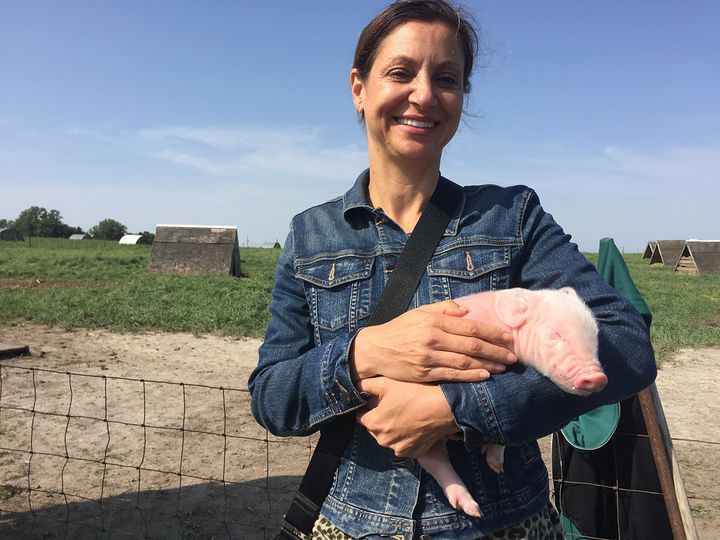“Superbugs”: it sounds like a Hollywood blockbuster about space aliens, or maybe a Pixar film about a fun-loving gang of insects wearing capes. But the antibiotic-resistant bacteria (aka “superbugs”) that have been hitting the headlines recently have nothing to do with Oscar nominations — and they are a real matter of life and death.
Antibiotics that doctors have long depended on to save human lives have stopped working. And part of the reason is that farmers abuse them in animal agriculture for non-medical reasons, giving rise to those “superbugs.” Here’s how that happened, and what you can do.
Debugging the myths
There’s a lot of confusion about why antibiotics are problematic in animal agriculture. I’ve met smart, well-informed people who think chickens are shot up with hormones to make them bigger. That’s just not true; the FDA doesn’t allow the use of artificial hormones in chickens. Or I’ve heard people say antibiotics are the reason why chickens have big breasts (nope, it’s selective breeding because Americans prefer white meat).
I was confused, too, until I had to help formulate an antibiotics policy for my own company. (Who knew that a company of chefs would need to immerse ourselves in microbiology?!) Originally I thought the problem was that we feed animals antibiotics and then by eating those animals, we get antibiotics into our own bodies. And that’s what creates antibiotic-resistant bacteria. Nope, that’s not it either. The government requires animals to be off drugs long enough before slaughter so there are no antibiotic traces in their meat. Technically speaking, then, all meat we consume should be “antibiotic-free.”
Here’s what the problem really is. In 1948 a biologist and chicken-feed expert named Thomas Jukes discovered that giving animals low doses of antibiotics made them grow faster. That was good news for the postwar pharmaceutical companies, and the poultry industry liked it, too. It became common practice.
The downside? Low-dosing a chicken (or any animal) with antibiotics kills only the weakest bacteria in their bodies, meaning the strongest strains of bacteria remain in the animal. Then, that stronger bacteria goes adventuring: from the farm animals’ waste into streams and other waterways as runoff, lurking on the surface of their meat (as Consumer Reports has documented extensively), and tagging along with workers, who inadvertently bring it home to their families on their clothes or skin. Why is this scary? Those surviving bacteria — the superbugs — are deadly.
Drug-free zones
In October, the FDA announced that levels of antibiotic-resistant bacteria in chicken had increased a whopping fourfold between 2011 and 2015. And just last week the World Health Organization (WHO) has just released a new set of recommendations about the use of antibiotics in food-producing animals with the chilling warning that “if no action is taken today, by 2050, almost all current antibiotics will be ineffective in preventing and treating human disease.” (While the USDA questioned the validity of the science in the WHO report, others argue that the recommendations are important, giving countries across the globe a starting point to take action.)
As Scientific American, Nature, and others — most notably Maryn McKenna, author of Superbugs and the recent Big Chicken — have reported, the use of antibiotics in agriculture has resulted in an army of superbugs. You’ve probably heard of Methicillin-resistant Staphylococcus aureus (MRSA), which is often said to kill more people than AIDS in the United States. Well, it’s got more than a dozen deadly pals on the Centers for Disease Control’s Biggest Threats list.
This army could have been nipped in the bug, um…bud. We know that animals can be raised without routine antibiotics, and by now most large poultry corporations have said that they won’t use them for growth promotion. However, it’s very hard to know if they are being used prophylactically (for instance, to compensate for dirty conditions) or not. The “Never Ever” movement has emerged as a response to the overuse of antibiotics on farms. Consumers and advocacy groups are demanding that under no circumstances do animals receive antibiotics during their lifetime. (Never. Ever.)
As a policy, Never Ever is easy for consumers to understand, but in practice I’m not sure it’s actually the best for animals, or for farmers. What happens when a calf gets pink eye and the farmer needs to treat it? Under the Never Ever model, the animal’s economic value plunges dramatically, from premium to commodity. Most large-scale producers run both Never Ever brands and conventional brands, so they can simply move that calf into the conventional supply. But for a small farmer who doesn’t have two types of buyers, Never Ever can be financially devastating. We don’t want farmers to have to choose between their animals’ welfare and their economic survival.
Never Ever land
Ideally there would be a third-party-verified policy that said antibiotics can be used judiciously to treat sick animals — just like in human medicine. There are groups working on that, like School Food FOCUS and The Pew Charitable Trusts’ joint Certified Responsible Antibiotic Use standard and the Natural Resources Defense Council, but you won’t see this meat in supermarkets or on restaurant menus yet. For now, it is still pretty much all (conventional) or nothing (never ever).
In this case, “nothing” is better. More and more supermarkets, fast-casual restaurants, and food service companies are switching to meat raised under “never ever” antibiotics policies. Look for USDA Certified Organic or clear labeling like you’ll see in Trader Joe’s and on brands like Perdue, Tyson, Farm Promise, Niman Ranch, and others available in grocery stores. Even Chik-fil-A has even committed to eliminating antibiotics by the end of 2019 (Chipotle and Panera have done so already) and Subway has a Never Ever choice. And when you’re shopping at the farmers’ market, ask your farmer what his or her antibiotics policy is. Show them you appreciate them using antibiotics carefully.
Because to squash those superbugs, we need everyone to don their capes, link arms, and start working together.

The author holding a newborn piglet on a Niman Ranch farm outside Des Moines, Iowa. Niman Ranch Pork has a “never ever” antibiotics policy.
